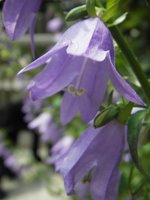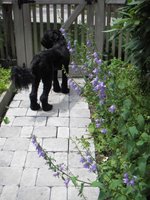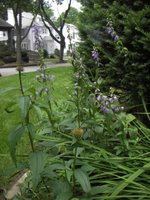



 This pretty blue flower is a really bad problem in my garden. This year I have let it go and it has flowered both in my side and front yard. Tempting to leave it, as the flowers are very nice. But it is horribly invasive and impossible to eliminate. I keep after it, sifting out the roots, and usually keep it in check. I’ll probably be in trouble next year for letting it go this year. It crowds out everything else. Here’s what some web sites have to say about it: “Creeping Bellflower (Campanula rapunculoides) is a native of Europe and was introduced to North America for its ornamental value. The root system of Creeping Bellflower is specially designed for long-term survival and persistence in cultivated conditions. Areas where it is moist and shady, this weed can become very invasive.” “Creeping bellflower has escaped from older gardens to become a weed. It is a perennial, 2 to 4 feet tall, and spreads by deep roots. Leaves are somewhat rough and lance-shaped, tapering to a point. The 1-inch flowers are purple, down-turned and bell shaped. It can become a serious weed problem in urban areas as well as in pastures and open fields.”http://www.sfn.saskatoon.sk.ca/science/splep/creeping_bellflower.html
This pretty blue flower is a really bad problem in my garden. This year I have let it go and it has flowered both in my side and front yard. Tempting to leave it, as the flowers are very nice. But it is horribly invasive and impossible to eliminate. I keep after it, sifting out the roots, and usually keep it in check. I’ll probably be in trouble next year for letting it go this year. It crowds out everything else. Here’s what some web sites have to say about it: “Creeping Bellflower (Campanula rapunculoides) is a native of Europe and was introduced to North America for its ornamental value. The root system of Creeping Bellflower is specially designed for long-term survival and persistence in cultivated conditions. Areas where it is moist and shady, this weed can become very invasive.” “Creeping bellflower has escaped from older gardens to become a weed. It is a perennial, 2 to 4 feet tall, and spreads by deep roots. Leaves are somewhat rough and lance-shaped, tapering to a point. The 1-inch flowers are purple, down-turned and bell shaped. It can become a serious weed problem in urban areas as well as in pastures and open fields.”http://www.sfn.saskatoon.sk.ca/science/splep/creeping_bellflower.html
creeping bellflower
---

9 Comments. Leave new
intersting blogs!!
i’m glad having found this
you must be living a colourful life
I have that same plant in my yard. I pulled most of it out because of its tendency to crowd everything else out. It seems rather hard to get rid of and bits of it have popped up among other perennials.
(it is pictured a few months back on my garden blog http://www.zoneonegarden.blogspot.com under the synonym Adenophora, another name for this Campanula)
This lovely plant is completely edible root to flower, higher in calcium than spinach, the leaves taste sweet, as do the flowers. you can eat them fresh or sauteed in butter as you would spinach. the flowers make a colorful addtion to salads, and the stems can be sautteed the same way as a side dish. YUM! try it, you may find that this plant can significantly benefit your salads, and takes zero work, as you know.. you may change your mindset from remove to regulate.. don’t take my word for it, go pop a few leaves off (assuming there are neither pesti, or, herbi -cides on them) rinse and enjoy..
I don’t know. I’m pretty cautions about eating something new. But other sources say they are edible too. This article: http://www.arthurleej.com/a-creepbellflower.html describes the flavor of the leaves as “utterly bland, but some Europeans eat [them] anyway”. Doesn’t make me want to run out and try them. They do say the flowers and roots are tasty.
Of course, they are still, and (I’m resigned) always will be, all over my garden. I do enjoy the purple flower. My main goal is to control their invasiveness though my neighbor is not pleased about the ones that come under the fence. I tell her they were here long before me. “I didn’t plant them!”
She also gets my wandering scilla, bugelweed and violets. All lovely with gentle abundant flowers. But none quite so weedy and persistent as the bellflower.
Thanks for the comment!
My husband and I have this growing in our yard and up and down our back lane. We at first thought it was borage and ate a couple leaves off it and put it in our spaghetti sauce like adding spinach. Then I looked on the net and saw that it was not borage growing and someone from my work told me what it was and I found your website. I have one question. How can we store this crazy edible weed.
Sorry I don't know. Maybe someone else can add a note here if they know.
As long as you cut the seed pods while they are still green, then they only spread by rhizome. This significantly slows the spread and keeps them from popping up in unexpected places. One stem can produce many hundreds of seeds if let go that far. And once the seed pods had tured brown it is impossible to cut them without spilling the tiny seeds everywhere. I like to grow these plants in problems areas where other plants do poorly. Have never tried eating them, but will certainly give it a try!
I like to let these grow a bit here and there. As you said, they fill in those problem areas and are quite pretty in bloom.
I will keep and eye on the seed stalks and remove them. Good idea. My neighbor is not pleased with the ones that have crept under the fence.
We are state certified tree nursery specializing in native plants and trees, shrubs, fern, and perennials as well as pond plants and wetland mitigation species.